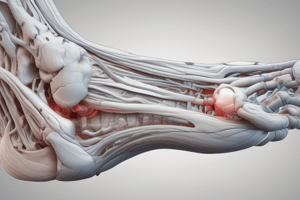Podcast
Questions and Answers
What is the typical angle of inclination in the frontal plane for an adult?
What is the typical angle of inclination in the frontal plane for an adult?
- 150°
- 110°
- 144°
- 125° (correct)
What is the term for an increased angle of inclination in the frontal plane?
What is the term for an increased angle of inclination in the frontal plane?
- Coxa valga (correct)
- Frontal plane motion
- Coxa vara
- Leg length discrepancy
What is the primary function of the hip during bilateral support of the HAT?
What is the primary function of the hip during bilateral support of the HAT?
- To provide stability to the upper body (correct)
- To facilitate movement of the leg on the trunk
- To initiate movement of the arms and head
- To allow movement of the trunk on the leg
What is the effect of coxa valga on the weight bearing of the head of the femur?
What is the effect of coxa valga on the weight bearing of the head of the femur?
What is the effect of coxa vara on the moment arms of gluteus medius and minimus?
What is the effect of coxa vara on the moment arms of gluteus medius and minimus?
In a closed kinematic chain, which part of the body is moving?
In a closed kinematic chain, which part of the body is moving?
At what stage of life is the angle of inclination in the frontal plane typically 150°?
At what stage of life is the angle of inclination in the frontal plane typically 150°?
What is the name of the kinematic chain where the movement of the leg is on the trunk?
What is the name of the kinematic chain where the movement of the leg is on the trunk?
In optimal posture, what is the characteristic of the line of gravity in the coronal plane?
In optimal posture, what is the characteristic of the line of gravity in the coronal plane?
What is the term for a decreased angle of inclination in the frontal plane?
What is the term for a decreased angle of inclination in the frontal plane?
What is the term for the hip's ability to support the head, arms, and trunk on one leg?
What is the term for the hip's ability to support the head, arms, and trunk on one leg?
What is the direction of the external flexion moments in a flexed-knee posture?
What is the direction of the external flexion moments in a flexed-knee posture?
Flashcards are hidden until you start studying




